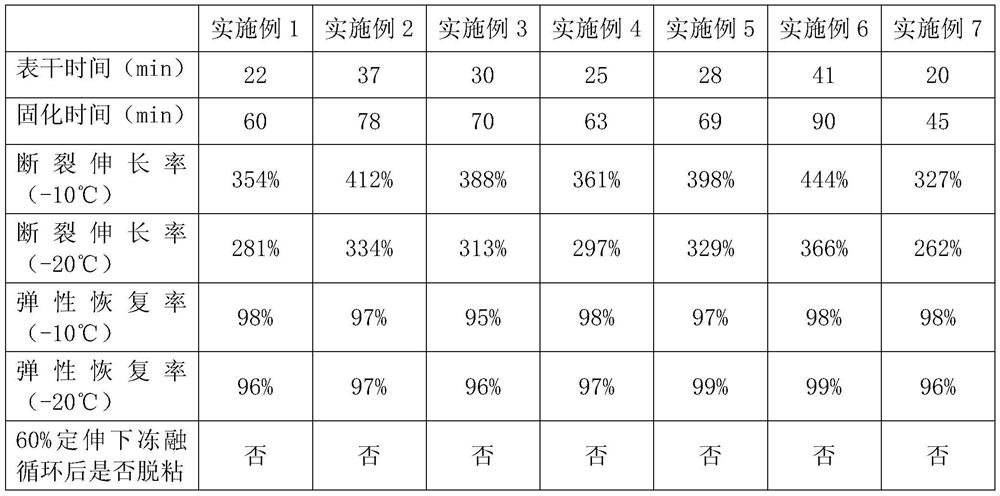Bridge expansion joint protective pouring system
A technology of expansion joints and systems, applied in the direction of non-polymer adhesive additives, adhesive types, adhesives, etc., can solve the problems of reduced deformation capacity of bridge expansion joints, closed traffic for a long time, reduced traffic efficiency, etc., to achieve shortening Time to open traffic, excellent elasticity, and short surface-drying time
- Summary
- Abstract
- Description
- Claims
- Application Information
AI Technical Summary
Problems solved by technology
Method used
Image
Examples
Embodiment 1
[0055] Step 1, the preparation of polyurethane prepolymer
[0056] 10 parts by mass of polyethylene glycol (Mn=2000) and 10 parts by mass of polyether polyol (Mn=3000) were heated in vacuum to remove water, then added to the reaction kettle, and 5 parts by mass of iso Phorone diisocyanate, 0.5 parts by mass of dibutyltin dilaurate, and 0.5 parts by mass of ethanolamine were reacted at 60°C for 1 hour to obtain a polyurethane prepolymer;
[0057] Step 2, the preparation of A component
[0058] Add 5 parts by mass of dibutyl phthalate, 1 part by mass of BYK070, 7 parts by mass of talcum powder and calcium carbonate powder into a vacuum reactor to remove water, and then add 1 part by mass of Dibutyltin dilaurate, 0.5 parts by mass of trimethyl orthoformate, and 30 parts by mass of polyurethane prepolymer prepared in step 1 are mixed in a vacuum environment, sealed and stored to obtain component A;
[0059] Step 3, preparation of component B
[0060] Mix 10 parts by mass of bis...
Embodiment 2
[0065] Step 1, the preparation of polyurethane prepolymer
[0066] 50 parts by mass of polyethylene glycol (Mn=2000) and 40 parts by mass of polyether polyol (Mn=3000) were heated in a vacuum to remove water, then added to the reactor, and 20 parts by mass were added under nitrogen protection. The equivalent blend of toluene diisocyanate and diphenylmethane diisocyanate, 1 mass part of diethanolamine, and 1 mass part of stannous octoate were reacted at 70°C for 2 hours to obtain a polyurethane prepolymer;
[0067] Step 2, the preparation of A component
[0068] 10 parts by mass of dioctyl phthalate, an equal blend of ethyl acetate, 5 parts by mass of BYK024 and an equal amount of HX-2085, 20 parts by mass of kaolin and silica powder The blend is added in a vacuum reactor to dewater, then add 5 mass parts of dibutyltin dilaurate, 2 mass parts of trimethyl orthoformate, the polyurethane prepolymer of 60 mass parts that step 1 makes, in a vacuum Mix under ambient conditions, se...
Embodiment 3
[0075] Step 1, the preparation of polyurethane prepolymer
[0076] 45 parts by mass of polyethylene glycol (Mn=4000) and 25 parts by mass of polyether polyol (Mn=5000) were heated in a vacuum to remove water, then added to the reactor, and 15 parts by mass were added under nitrogen protection. 1,6-hexamethylene diisocyanate, 1 mass part of dibutyltin dilaurate, and 0.6 mass part of ethanolamine were reacted at 80°C for 1 hour to obtain a polyurethane prepolymer;
[0077] Step 2, the preparation of A component
[0078] Add 8 parts by mass of ethyl acetate, butyl acetate and an equal blend of butyl acetate, 3 parts by mass of BYK024, 7 parts by mass of talcum powder, and 6 parts by mass of diatomaceous earth into a vacuum reactor for removal. Water, then add 3 mass parts of dibutyltin dilaurate, 1 mass part of trimethyl orthoformate, the polyurethane prepolymer of 45 mass parts that step 1 makes, mix under vacuum environment, seal and preserve promptly to get A components;
...
PUM
| Property | Measurement | Unit |
|---|---|---|
| Functional group degree | aaaaa | aaaaa |
Abstract
Description
Claims
Application Information
 Login to View More
Login to View More - R&D
- Intellectual Property
- Life Sciences
- Materials
- Tech Scout
- Unparalleled Data Quality
- Higher Quality Content
- 60% Fewer Hallucinations
Browse by: Latest US Patents, China's latest patents, Technical Efficacy Thesaurus, Application Domain, Technology Topic, Popular Technical Reports.
© 2025 PatSnap. All rights reserved.Legal|Privacy policy|Modern Slavery Act Transparency Statement|Sitemap|About US| Contact US: help@patsnap.com

